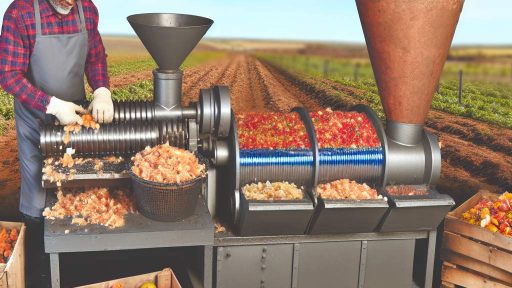Overview of Farm-to-Restaurant Programs
Definition and Importance
Farm-to-restaurant programs connect local farms directly with restaurants.
These initiatives emphasize the importance of fresh, locally sourced ingredients.
Restaurants benefit from higher quality produce and unique flavors.
Additionally, these programs support local economies and farmers.
They foster a deep relationship between chefs and producers.
Transparency becomes a core aspect of sourcing practices.
By choosing local, restaurants reduce their carbon footprint.
Moreover, these programs create a variety of seasonal menus.
Farm-to-restaurant initiatives promote sustainability within the food industry.
They encourage practices that respect the environment and community welfare.
As customers grow more conscious, they seek out these dining options.
Thus, farm-to-restaurant programs lead to greater consumer awareness.
This trend highlights the need for strong partnerships across the supply chain.
Farm-to-restaurant collaborations vary in structure and scope.
Some restaurants form exclusive partnerships with specific farms.
Transform Your Agribusiness
Unlock your farm's potential with expert advice tailored to your needs. Get actionable steps that drive real results.
Get StartedOthers may engage in community-supported agriculture (CSA) programs.
Overall, these models improve the accessibility of local produce.
As a result, they inspire culinary creativity among chefs.
In essence, farm-to-restaurant programs are vital for modern dining.
Benefits for Farmers: Increased Revenue and Market Access
Enhanced Profitability
Farm-to-restaurant programs boost farmers’ profitability.
These programs provide a direct sales avenue for fresh produce.
Farmers earn higher prices compared to traditional wholesale markets.
Consequently, they can invest more in sustainable practices.
Reduced Dependence on Intermediaries
Working directly with restaurants lowers reliance on middlemen.
This change allows farmers to retain a larger share of the sale price.
Additionally, farmers can establish long-term relationships with clients.
Such relationships foster loyalty and can lead to repeat business.
Increased Market Access
Farm-to-restaurant programs open new markets for farmers.
Restaurants often seek local and seasonal produce.
This demand helps farmers diversify their customer base.
Moreover, they can reach consumers who prioritize local sourcing.
Stronger Community Connections
Farmers build stronger relationships within their communities.
By supplying local restaurants, they contribute to the local economy.
These connections enhance community pride and awareness of local agriculture.
In turn, consumers become more invested in supporting local food systems.
Improved Product Awareness
Participating in farm-to-restaurant programs raises product visibility.
Restaurants often promote the origins of their ingredients.
This storytelling helps consumers make informed choices.
As a result, farmers’ products gain recognition and respect.
Showcase Your Farming Business
Publish your professional farming services profile on our blog for a one-time fee of $200 and reach a dedicated audience of farmers and agribusiness owners.
Publish Your ProfileBenefits for Restaurants: Freshness, Quality, and Sustainability
Enhancing Freshness
Farm-to-restaurant programs provide unbeatable freshness.
Local produce arrives at restaurants shortly after harvest.
This quick turnover enhances flavor and nutritional value.
Furthermore, farmers often harvest in response to restaurant orders.
This ensures that only the freshest items are selected.
Improving Quality
High-quality ingredients lead to exceptional dishes.
Farmers take pride in their produce and maintain high standards.
When restaurants source directly from local farms, they access premium products.
This direct relationship helps chefs craft unique, flavorful meals.
Additionally, restaurants can offer seasonal menu items that highlight quality ingredients.
Supporting Sustainability
Farm-to-restaurant programs promote sustainable agriculture practices.
By supporting local farmers, restaurants reduce their carbon footprints.
Transporting food over shorter distances minimizes environmental impact.
Moreover, local farms often employ eco-friendly methods.
This approach benefits both the environment and the community.
Building Community Connections
These programs foster strong community ties between restaurants and farms.
Chefs can share their culinary vision with local farmers.
This collaboration encourages the growth of diverse farming practices.
It also creates a sense of belonging within the local food system.
As a result, customers appreciate the connection to their food.
Enhancing Customer Experience
Consumers increasingly value transparency in their food sources.
Farm-to-restaurant sourcing promotes this transparency.
Chefs can share stories about local farmers with their patrons.
This connection enhances the dining experience and builds customer loyalty.
Ultimately, satisfied customers lead to repeat business for restaurants.
You Might Also Like: Biodiversity in Farming for Supporting Beneficial Insects
Key Components of Successful Farm-to-Restaurant Programs
Strong Relationships
Building strong relationships between farmers and restaurants is crucial.
Effective communication fosters trust and collaboration.
Regular meetings can enhance understanding of each other’s needs.
Moreover, joint events can promote shared values and goals.
Quality Produce
Quality is paramount in farm-to-restaurant programs.
Restaurants seek fresh, high-quality ingredients for their menus.
Farmers must prioritize sustainability to maintain high standards.
Furthermore, showcasing seasonal produce creates excitement among diners.
Transparent Pricing
Transparent pricing builds confidence between farmers and restaurants.
Both parties should agree on fair prices that benefit everyone.
Clear pricing structures help avoid misunderstandings in the future.
Additionally, farmers can offer volume discounts to encourage bulk purchasing.
Marketing and Promotion
Effective marketing plays a vital role in successful programs.
Promotion of local produce attracts more customers to restaurants.
Showcase Your Farming Business
Publish your professional farming services profile on our blog for a one-time fee of $200 and reach a dedicated audience of farmers and agribusiness owners.
Publish Your ProfileFarmers can assist by sharing stories about their products.
This approach adds value and engages diners emotionally.
Feedback and Improvement
Continuous feedback is essential for program success.
Restaurants should regularly provide input on produce quality and availability.
Farmers can use this feedback to make necessary adjustments.
Ultimately, improving based on feedback fosters long-term partnerships.
Discover More: Beneficial Insect Habitats: A Guide To Boosting Biodiversity On US Farms
Challenges Faced by Farmers and Restaurants in Direct Sales
Understanding the Current Landscape
Farm-to-restaurant programs have gained popularity in recent years.
However, both farmers and restaurants encounter significant challenges.
The primary challenge involves logistics and distribution efficiency.
Farmers must deliver fresh products promptly to maintain quality.
Restaurants depend on reliable delivery schedules for menu planning.
Additionally, seasonal availability complicates menu consistency.
Quality Control and Standards
Maintaining product quality poses another considerable challenge.
Farmers must adhere to food safety regulations at all times.
Restaurants require consistent quality for customer satisfaction.
Variations in harvested produce can lead to customer complaints.
Inconsistency undermines trust between farmers and restaurants.
Pricing and Profitability Issues
Price fluctuations create uncertainty for both parties involved.
Farmers often struggle to cover production costs during lean seasons.
Conversely, restaurants face tight margins and price sensitivity.
Establishing fair pricing models remains a critical concern.
Both must negotiate terms that benefit their bottom line.
Building and Maintaining Relationships
Establishing strong relationships is paramount for success.
Farmers and restaurant owners must communicate effectively.
Regular check-ins can ensure alignment on supply needs.
Building trust fosters collaboration and expands opportunities.
Moreover, personal connections can enhance product promotion.
Adapting to Changing Market Demands
Market trends are constantly evolving in the culinary landscape.
Bakeries and cafés increasingly seek locally sourced ingredients.
Farmers must adapt their offerings to align with these demands.
Flexibility in production can enhance marketability and sales.
Continual research on consumer preferences is essential for success.
Gain More Insights: Food Waste Reduction Benefits for Regenerative Farming Systems

Case Studies: Successful Farm-to-Restaurant Partnerships
The Local Harvest Initiative
The Local Harvest Initiative connects nearby farms with local restaurants.
This program encourages chefs to source seasonal produce directly.
For example, Chef Michael from Green Plate Diner prioritizes fresh vegetables.
He works with farmer Sarah, who grows organic heirloom tomatoes.
This partnership has increased customer satisfaction and menu diversity.
Furthermore, it supports the local economy and promotes sustainable practices.
Showcase Your Farming Business
Publish your professional farming services profile on our blog for a one-time fee of $200 and reach a dedicated audience of farmers and agribusiness owners.
Publish Your ProfileFresh Fork Cooperative
Fresh Fork Cooperative serves as a vital link between farmers and restaurants.
They provide a weekly selection of fresh, locally sourced ingredients.
Restaurants like The Artisan Table thrive by using their produce.
Owner Julia emphasizes the importance of knowing ingredient origins.
Additionally, this cooperative reduces the carbon footprint of food delivery.
By prioritizing local sources, restaurants can offer unique culinary experiences.
Community Supported Agriculture Programs
Community Supported Agriculture (CSA) programs offer fresh produce subscriptions.
These programs enable restaurants to feature exclusive seasonal items.
Chef Alex at The Rustic Kitchen leverages local CSAs for unique dishes.
He crafts menus based on what is available each week.
This model fosters creativity and adaptability in cooking.
Moreover, it strengthens ties between chefs and local farmers.
The Organic Exchange
The Organic Exchange focuses on certified organic farms and restaurants.
They promote ethical farming by ensuring fair trade practices.
One success story is Chef Maria from Farm & Feast.
She proudly uses ingredients from the Organic Exchange’s network.
This commitment improves meal quality and promotes health-conscious dining.
Clients appreciate the flavor and freshness of her dishes.
Urban Roots Development
Urban Roots Development fosters partnerships between urban farms and eateries.
Urban farmer Tom collaborates with local bistros to supply greens.
Restaurants benefit from having fresh salad ingredients just a mile away.
This reduces transportation costs and enhances the farm-to-table experience.
Additionally, it educates diners on the importance of local sourcing.
Such partnerships create a community that values local agriculture.
Discover More: Farm-to-Restaurant Programs for Local Farmers
Guidelines for Setting Up a Farm-to-Restaurant Program
Identifying Local Farmers
Start by researching local farms in your area.
Attend farmers’ markets to connect with producers directly.
Utilize community bulletins and social media platforms to find local growers.
Consider setting up meetings with farmers to discuss potential partnerships.
Establishing Partnerships
Once you’ve identified local farmers, initiate contact promptly.
Discuss expectations and product availability with them.
Create agreements outlining delivery schedules and pricing structures.
Ensure both parties understand the requirements and quality expectations.
Creating a Menu with Seasonal Produce
Develop your restaurant menu around seasonal produce.
Highlight the unique offerings of local farms on your menu.
Consider creating daily specials featuring fresh ingredients.
Engage your chefs in the planning process for menu development.
Marketing Your Program
Promote your farm-to-restaurant initiatives through various channels.
Use social media to showcase your partnerships and local ingredients.
Share stories about the farms and farmers with your customers.
Showcase Your Farming Business
Publish your professional farming services profile on our blog for a one-time fee of $200 and reach a dedicated audience of farmers and agribusiness owners.
Publish Your ProfileEncourage word-of-mouth marketing by inviting customers to share experiences.
Monitoring and Evaluating Success
Regularly assess the effectiveness of your farm-to-restaurant program.
Gather feedback from staff and customers on menu items.
Analyze sales data to identify popular dishes featuring local produce.
Adjust your partnerships and menu offerings based on this feedback.
Marketing Strategies for Promoting Local Produce to Restaurants
Building Relationships with Chefs
Establishing strong connections with local chefs is essential.
Start by introducing yourself and your farm.
Participate in local food events to network effectively.
Offer farm tours to showcase your growing practices.
Provide sample produce to let chefs experience quality firsthand.
Utilizing Social Media Platforms
Social media is a powerful tool for reaching restaurants.
Share vibrant images of your produce on platforms like Instagram.
Engage with restaurant accounts to boost visibility.
Use relevant hashtags to gain a wider audience.
Create a consistent posting schedule to maintain interest.
Creating Informative Marketing Materials
Develop brochures that highlight your farm’s story.
Include details about your growing practices and produce varieties.
Use eye-catching visuals to attract attention.
Provide information on the benefits of sourcing local produce.
Ensure your contact information is easily accessible.
Participating in Local Farmers’ Markets
Farmers’ markets serve as excellent platforms for visibility.
Set up a booth to display your produce to potential buyers.
Network with chefs and restaurant owners attending the market.
Offer special deals for bulk purchases targeting restaurants.
Engaging with customers can lead to valuable referrals.
Collaborating with Local Food Distributors
Partnering with food distributors can enhance your reach.
Work together to promote your locally sourced produce.
Ensure they understand the quality and uniqueness you provide.
Maintain close communication to meet restaurant demands.
Regularly discuss promotional strategies to boost sales.
Hosting Tasting Events
Organize tasting events specifically for local chefs.
Present dishes prepared with your fresh produce.
Encourage feedback and suggestions from chefs attending.
Highlight seasonal produce to inspire unique menu creations.
Follow up with attendees to nurture ongoing relationships.
Additional Resources
The Farm-to-Table Movement: A Complete Guide — Hitchcock Farms




